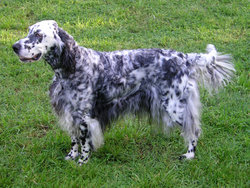
Laverack
Llewellin (or Llewellyn) Setter
|
From Wikipedia the free encyclopedia, by MultiMedia |
| English Setter | ||
|---|---|---|

A white and black English Setter
|
||
| Alternative names | ||
| Lawerack Laverack Llewellin (or Llewellyn) Setter |
||
| Country of origin | ||
| United Kingdom | ||
| Common nicknames | ||
| Classification and breed standards | ||
| FCI: | Group 7 Section 2 #2 | |
| AKC: | Sporting | |
| ANKC: | Group 3 (GunDogs) | |
| CKC: | Group 1 - Sporting Dogs | |
| KC (UK): | GunDog | |
| NZKC: | GunDog | |
| UKC: | Gun Dog Breeds | |
| Not recognized by any major kennel club | ||
| This breed of Dog is extinct | ||
| Notes | ||
The English Setter is a breed of Dog. It is part of the Setter family, which includes red Irish Setters and black Gordon Setters.
The English Setter is a gun Dog, bred for a mix of endurance and athleticism. The coat is flat with light feathering of long length. They have a long, flowing coat that requires regular grooming.
The various speckled coat colors when occurring in English Setters are referred to as belton; valid combinations are white with black flecks (blue belton) or with orange flecks (orange belton— depending on the intensity of the color, they might be lemon belton or liver belton), or white with black and tan flecks (tricolour belton).
This breed's standard temperament can be described as friendly and good natured, however, it can also be strong-willed and mischievous. They are energetic, people-oriented Dogs, so are well suited to families who can give them attention and activity, or to working with a hunter, where they have a job to do. They are active Dogs that need plenty of exercise.
A relatively healthy breed, Setters have few genetic problems but some problems occasionally occur. Canine Hip dysplasia, Elbow dysplasia, and canine hypothyroidism are some of the more well-known ailments that can affect this Dog.
The English Setter was originally bred to set or point upland game birds. From the best available information, it appears that the English Setter was a trained bird Dog in England more than 400 years ago. There is evidence that the English Setter originated in crosses of the Spanish Pointer, large Water Spaniel, and Springer Spaniel, which combined to produce an excellent bird Dog with a high degree of proficiency in finding and pointing game in open country. The modern English Setter owes its appearance to Mr. Edward Laverack (1800-1877), who developed his own strain of the breed by careful inbreeding during the 19th century in England and to another Brit, Mr. R. Purcell Llewellin (1840-1925), who based his strain upon Laverack's and developed the working Setter. Today, you still hear the term Llewellin Setter, but this is not a separate breed. Instead, it is often used as an alternate name for a field-bred English Setter.
With time, Laverack inbred successfully to produce beautiful representatives of the breed. The first show for English Setters was held in 1859 at Newcastle-on-Tyne. The breed's popularity soared across England as shows became more and more widespread. Not long after, the first English Setters were brought to North America, including those that began the now-famous Llewellin strain recorded in the writing of Dr. William A Burette. From this group of Dogs came the foundation of the field-trial setter in America, "Count Noble," who is currently mounted in the Carnegie Museum at Pittsburgh. At present, the English is one of the most popular and elegant sporting breeds, often grouped with its cousins, the Irish and Gordon Setters.
The name Llewellin Setter is given to a certain strain of English Setters bred by R.L. Purcell Llewellin (also spelled Llewellyn) to be perfect for field trials.



Dogs, made by MultiMedia | Free content and software
This guide is licensed under the GNU Free Documentation License. It uses material from the Wikipedia.